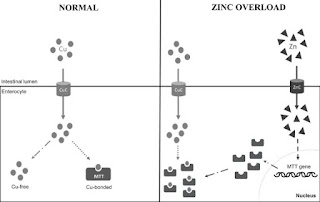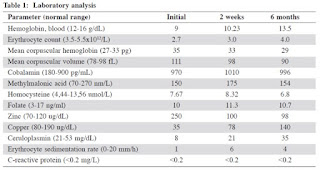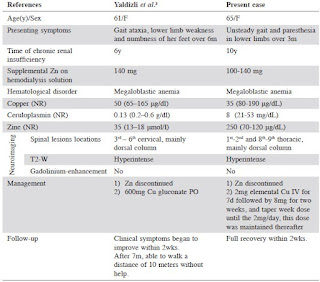Article type:
Case Report
Article
title: Copper deficiency
myelopathy secondary to parenteral zinc supplementation during chronic dialysis
Journal: Neurology
Asia
Year: 2019
Authors: Jamir Pitton Rissardo, Ana Letícia Fornari
Caprara
E-mail: jamirrissardo@gmail.com
ABSTRACT
Copper deficiency
myelopathy secondary to parenteral zinc supplementation during chronic
hemodialysis has rarely reported in the literature. An elderly woman presenting
with unsteady gait and paresthesia in lower limbs was admitted to our hospital.
She has been having chronic renal insufficiency managed with hemodialysis and
zinc-supplementation for the past ten years. The neurological examination
showed that light touch, vibration, proprioception, and the deep tendon
reflexes were symmetrically reduced in both lower limbs. The spine-MRI revealed
hyperintensity lesions on thoracic segments. The laboratory tests showed
anemia, elevated zinc, and reduced copper and ceruloplasmin levels.
Zinc-supplementation was discontinued and elemental copper was started. Two
weeks later, the patient had a full recovery. In the follow-up six months
later, all the laboratory tests were normal and investigations to search for
immune suppression, vasculitis, and infection were negative.
Keywords: Copper, dialysis, myelopathy
Full text
available at:
Citation
Rissardo JP,
Caprara AL. Copper deficiency myelopathy secondary to parenteral zinc
supplementation during chronic dialysis. Neurology Asia 2019;24:79-82
Figure 1. Relation between zinc and copper in the enterocyte. In copper-zinc normal intake and in zinc overload intake. Abbreviations: copper (Cu); copper channel (CuC); metallothionein (MTT); metallothionein gene (MTT gene); zinc (Zn); zinc channel (ZnC).
Table 1. Laboratory analysis.
Table 2. Case reports of patients with copper deficiency myelopathy secondary to zinc supplementation during dialysis.


